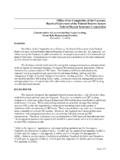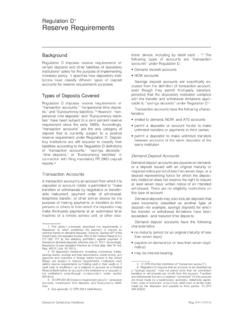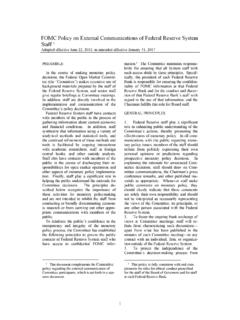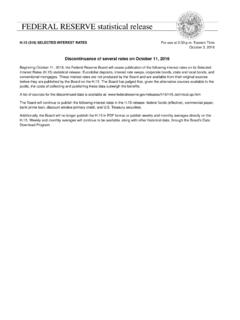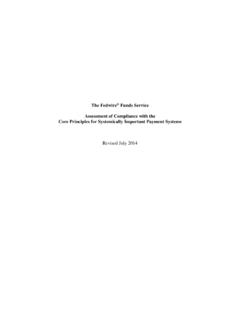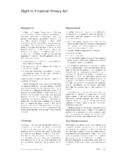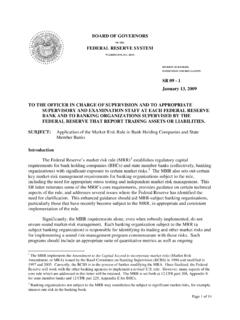Transcription of Regulation DD Truth in Savings - Federal Reserve System
1 Regulation DDTruth in SavingsBackgroundRegulation DD (12 CFR 230), which implementsthe Truth in Savings Act (TISA), became effectivein June 1993. An official staff commentaryinterprets the requirements of Regulation DD(12 CFR 230 (Supplement I)). Since then, severalamendments have been made to Regulation DDand the Staff Commentary, including changes,effective January 1, 2010, concerning disclosuresof aggregate overdraft and returned item fees onperiodic statements and balance disclosuresprovided to consumers through automated addition, effective July 6, 2010, clarificationswere made to the provisions related to overdraftservices (NOTE: The effective date for theclarification to section (a)(1)(i), requiringthe term Total Overdraft Fees to be used, isOctober 1, 2010) (75 FR 31673).
2 The purpose of Regulation DD is to enableconsumers to make informed decisions about theiraccounts at depository institutions through the useof uniform disclosures. The disclosures aid com-parison shopping by informing consumers aboutthe fees, annual percentage yield, interest rate, andother terms for deposit accounts. A consumer isentitled to receive disclosures When an account is opened; Upon request; When the terms of the account are changed; When a periodic statement is sent; and For most time accounts, before the Regulation also includes requirements on thepayment of interest, the methods of calculating thebalance on which interest is paid, the calculation ofthe annual percentage yield, and ( ) Regulation DD applies to all depository institutions,except credit unions, that offer deposit accounts toresidents of any state.
3 Branches of foreign institu-tions located in the United States are subject toRegulation DD if they offer deposit accounts toconsumers. Edge Act and agreement corporations,and agencies of foreign institutions, are not deposi-tory institutions for purposes of Regulation addition, persons who advertise accounts aresubject to the advertising rules. For example, if adeposit broker places an advertisement offeringconsumers an interest in an account at a deposi-tory institution, the advertising rules apply to theadvertisement, whether the account is to be heldby the broker or directly by the ( )Section defines key terms used in Regula-tion DD. Among those definitions are the following:Account ( (a))Anaccountis a deposit account at a depositoryinstitution that is held by, or offered to, a includes time, demand, Savings , and negotiableorder of withdrawal accounts.
4 Regulation DDcovers interest-bearing as well as noninterest-bearing ( (b))Anadvertisementis a commercial message, ap-pearing in any medium, that promotes directly orindirectly (a) the availability or terms of, or a depositin, a new account, and (b) for purposes ofsections (a) (misleading or inaccurate adver-tisements) and (additional disclosurerequirements for institutions advertising the pay-ment of overdrafts), the terms of, or a deposit in, anew or existing account. An advertisement includesa commercial message in visual, oral, or printmedia that invites, offers, or otherwise announcesgenerally to prospective customers the availabilityor terms of, or a deposit in, a consumer of advertisements include telephonesolicitations and messages on automated tellermachine Percentage Yield ( (c))Anannual percentage yieldis a percentage ratereflecting the total amount of interest paid on anaccount, based on the interest rate and thefrequency of compounding for a 365-day period or366-day period during leap years and calculatedaccording to the rules in Appendix A of Regula-tion DD.
5 Interest or other earnings are not to beincluded in the annual percentage yield if thecircumstances for determining the interest andother earnings may or may not occur in the futureConsumer Compliance HandbookReg. DD 1(12/10)(see Appendix A, footnote 1).Average Daily Balance Method( (d))The average daily balance methodis the applica-tion of a periodic rate to the average daily balancein the account for the period. The average dailybalance is determined by adding the full amount ofprincipal in the account for each day of the periodand dividing that figure by the number of days inthe ( (e))The Boardmeans the Board of Governors of theFederal Reserve ( (f))Abonusis a premium, gift, award, or otherconsideration worth more than $10 (whether in theform of cash, credit, merchandise, or any equiva-lent) given or offered to a consumer during a year inexchange for opening, maintaining, renewing, orincreasing an account balance.
6 The term does notinclude interest, other consideration worth $10 orless given during a year, the waiver or reduction ofa fee, or the absorption of Day ( (g))Abusiness dayis a calendar day other than aSaturday, a Sunday, or any of the legal publicholidays specified in 5 USC 6103(a).Consumer ( (h))Aconsumeris a natural person who holds anaccount primarily for personal, family, or householdpurposes, or to whom such an account is term does not include accounts held by anatural person on behalf of another in a profes-sional capacity or accounts held by individuals assole Balance Method ( (i))Thedaily balance methodis the application of adaily periodic rate to the full amount of principal inthe account each Institution ( (j))Adepository institutionand aninstitutionareinstitutions defined in section 19(b)(1)(A)(i)-(vi) ofthe Federal Reserve Act (12 USC 461), exceptcredit unions defined in section 19(b)(1)(A)(iv).
7 Branches of foreign institutions located in theUnited States are subject to the Regulation if theyoffer deposit accounts to consumers. Edge Act andagreement corporations, and agencies of foreigninstitutions, are not depository institutions for pur-poses of this Broker ( (k))Adeposit brokeris a person who is in the businessof placing or facilitating the placement of depositsin an institution, as defined by section 29(g) of theFederal Deposit Insurance Act (12 USC 1831f(g))Fixed-Rate Account ( (l))Afixed-rate accountis an account for which theinstitution contracts to give at least 30 calendardays advance written notice of decreases in theinterest Period ( (m))Agrace periodis a period following the maturity ofan automatically renewing time account duringwhich the consumer may withdraw funds withoutbeing assessed a ( (n))Interestis any payment to a consumer or to anaccount for the use of funds in an account,calculated by applying a periodic rate to thebalance.
8 Interest does not include the payment of abonus or other consideration worth $10 or lessduring a year, the waiver or reduction of a fee, orthe absorption of Rate ( (o))Aninterest rateis the annual rate of interest paid onan account and does not reflect compounding. Forpurposes of the account disclosures in sec-tion (b)(1)(i), the interest rate may, but neednot, be referred to as the annual percentage rate in addition to being referred to as the interestrate. Passbook Savings Account ( (p))Apassbook Savings accountis a Savings accountin which the consumer retains a book or otherdocument in which the institution records transac-tions on the account. Passbook Savings accountsinclude accounts accessed by preauthorized elec-tronic fund transfers to the account.
9 As defined inRegulation E, a preauthorized electronic fundtransfer is an electronic fund transfer authorized inadvance to recur at substantially regular include an account that receives directTruth in Savings2 (12/10) Reg. DDConsumer Compliance Handbookdeposit of Social Security payments. Accountspermitting access by other electronic means arenot passbook Savings accounts and must complywith the requirements of section if statementsare sent four or more times a Statement ( (q))Aperiodic statementis a statement setting forthinformation about an account (other than a timeaccount or passbook Savings account) that isprovided to a consumer on a regular basis four ormore times a ( (r))Astateis a state, the District of Columbia, thecommonwealth of Puerto Rico, and any territory orpossession of the United Account ( (s))
10 Astepped-rate accountis an account that has twoor more interest rates that take effect in succeedingperiods and are known when the account Account ( (t))Atiered-rate accountis an account that has two ormore interest rates that are applicable to specifiedbalance levels. A requirement to maintain a mini-mum balance to earn interest does not make anaccount a tiered-rate Account ( (u))Atime accountis an account with a maturity of atleast seven days in which the consumer generallydoes not have a right to make withdrawals for sixdays after the account is opened, unless thedeposit is subject to an early withdrawal penalty ofat least seven days interest on the Account ( (v))Avariable-rate accountis an account in which theinterest rate may change after the account isopened, unless the institution contracts to give atleast 30 calendar days advance written notice ofrate Disclosure Requirements( )General Requirements ( (a) and(b))
